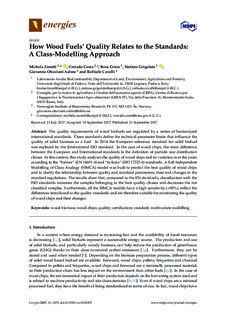| dc.contributor.author | Zanetti, Michela | |
| dc.contributor.author | Costa, Corrado | |
| dc.contributor.author | Greco, Rosa | |
| dc.contributor.author | Grigolato, Stefano | |
| dc.contributor.author | Ottaviani Aalmo, Giovanna | |
| dc.contributor.author | Cavalli, Raffaele | |
| dc.date.accessioned | 2018-03-22T12:31:42Z | |
| dc.date.available | 2018-03-22T12:31:42Z | |
| dc.date.created | 2018-02-26T08:45:15Z | |
| dc.date.issued | 2017-09-21 | |
| dc.identifier.citation | Zanetti, M.; Costa, C.; Greco, R.; Grigolato, S.; Ottaviani Aalmo, G.; Cavalli, R. How Wood Fuels’ Quality Relates to the Standards: A Class-Modelling Approach. Energies 2017, 10, 1455. | nb_NO |
| dc.identifier.issn | 1996-1073 | |
| dc.identifier.uri | http://hdl.handle.net/11250/2491712 | |
| dc.description.abstract | The quality requirements of wood biofuels are regulated by a series of harmonized international standards. These standards define the technical parameter limits that influence the quality of solid biomass as a fuel. In 2014 the European reference standard for solid biofuel was replaced by the International ISO standard. In the case of wood chips, the main difference between the European and International standards is the definition of particle size distribution classes. In this context, this study analyses the quality of wood chips and its variation over the years according to the “former” (EN 14691-4) and “in force” (ISO 17225-4) standards. A Soft Independent Modelling of Class Analogy (SIMCA) model was built to predict the best quality of wood chips and to clarify the relationship between quality and standard parameters, time and changes in the standard regulations. The results show that, compared to the EN standards, classification with the ISO standards increases the samples belonging to the best quality classes and decreases the not classified samples. Furthermore, all the SIMCA models have a high sensitivity (>90%), reflect the differences introduced to the quality standards and are therefore suitable for monitoring the quality of wood chips and their changes. | nb_NO |
| dc.language.iso | eng | nb_NO |
| dc.publisher | MDPI AG, Basel, Switzerland | nb_NO |
| dc.rights | Navngivelse 4.0 Internasjonal | * |
| dc.rights.uri | http://creativecommons.org/licenses/by/4.0/deed.no | * |
| dc.subject | wood biomass | nb_NO |
| dc.subject | wood chips | nb_NO |
| dc.subject | quality | nb_NO |
| dc.subject | certification | nb_NO |
| dc.subject | standard | nb_NO |
| dc.subject | standard | nb_NO |
| dc.subject | multivariate modelling | nb_NO |
| dc.title | How wood fuels' quality relates to the standards: A class-modelling approach | nb_NO |
| dc.type | Journal article | nb_NO |
| dc.type | Peer reviewed | nb_NO |
| dc.description.version | publishedVersion | nb_NO |
| dc.rights.holder | © 2017 by the authors. | nb_NO |
| dc.source.volume | 10 | nb_NO |
| dc.source.journal | Energies | nb_NO |
| dc.source.issue | 10 | nb_NO |
| dc.identifier.doi | 10.3390/en10101455 | |
| dc.identifier.cristin | 1568535 | |
| cristin.ispublished | true | |
| cristin.fulltext | original | |
| cristin.qualitycode | 1 | |

